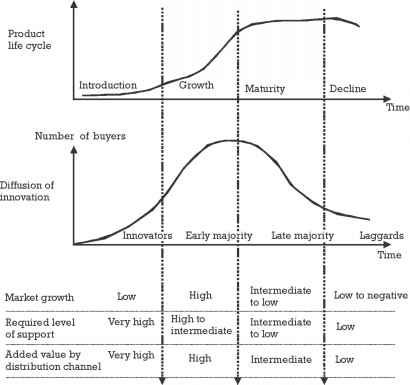Managing a hightech product according to its product life cycle
The importance of the product life cycle must be examined via the changes in markets and technology, because a high-tech product exists not only because it meets a market need but because it is closely related to a technology.
We saw in Chapter 1 that the product life cycle is the mirror image of the changing needs that the product satisfies and reflects the customer diffusion of innovation curve (see Figure 6.5). At its introduction, the product must convince the innovators and the forerunners because as soon as they buy the product and make it popular, a larger majority will be interested in the product. Sales will increase until the late majority has adopted the product and its level of sales stabilizes. Finally, the eventual decline will be accelerated by the arrival of a new technology.
Furthermore, fast-changing technologies and the customer's failure to understand a technique encourage fads for a given product. As many product managers know, in the consumer and industrial high-tech world, the product life cycle is quite similar to that of "faddish" products: Both have a quick growth stage and a sharp decline.
For example, over the last 10 years, the average life cycle of the PC has decreased from 4 years to 9 months. At a given time, 70% of the products in the portfolio of a typical PC vendor have been introduced in the last 6 months. Consequently, manufacturers must juggle powerful suppliers' demanding lead times as high as 4 months (like for disk drives) and distributors unwilling to carry large inventories. Other industries such as mobiles
Units
Units

- Figure 6.5 Product life cycle and diffusion of innovation.
phones, consumer electronics, and publishing, as well as fashion and sporting goods, face many of the same problems.
Siemens has even made the decision to reduce its Xelibri mobile phones' life cycle on purpose. The Xelibri phones are marketed as fashion accessories, with spring/summer and fall/winter collections. Each collection consists of four phones only;they are available in limited quantities and have a life cycle of 12 months, significantly shorter than average mobile phones.
The product life cycle theory is sometimes criticized for two reasons. On one hand, it is very difficult to identify stages because they are led by sales that can be influenced by marketing activities. On the other hand, there is no reliable way to identify when stages actually change, particularly to identify signs of maturity or decline.
Nevertheless, in the high-tech-product world this model appears to be very useful to the product manager, not so much for making market predictions, but rather for planning and preparing strategic product management decisions. Every stage of a life cycle requires different actions, as we will now examine in detail.
Continue reading here: Managing distributors of hightech products
Was this article helpful?